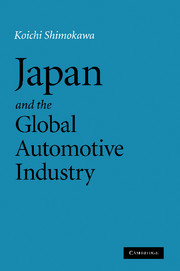Book contents
- Frontmatter
- Contents
- List of figures
- List of tables
- Preface
- Introduction
- 1 Comparing productivity of the Japanese and US automobile industries
- 2 The internationalization of the Japanese automotive industry and local production overseas
- 3 The recovery of European and US auto makers, and relocating and changing lean production
- 4 Early 1990s – the Japanese automotive industry loses international competitiveness, and the development of restructuring strategies
- 5 The restructuring of the global automotive and auto-parts industries
- 6 The restructuring of the world's auto-parts industry and the transfiguration of the keiretsu parts transaction
- 7 Global M&A and the future of the global auto industry – the light and dark sides of merger and re-alignment
- 8 The Asian and ASEAN automotive industries in the global era
- 9 China's automotive industry in the global era, Japanese auto makers, and their China strategies
- 10 Conclusion – the global automotive industry's perspective on the twenty-first century and tasks for the Japanese automotive industry
- Epilogue
- Index
- References
4 - Early 1990s – the Japanese automotive industry loses international competitiveness, and the development of restructuring strategies
Published online by Cambridge University Press: 06 July 2010
- Frontmatter
- Contents
- List of figures
- List of tables
- Preface
- Introduction
- 1 Comparing productivity of the Japanese and US automobile industries
- 2 The internationalization of the Japanese automotive industry and local production overseas
- 3 The recovery of European and US auto makers, and relocating and changing lean production
- 4 Early 1990s – the Japanese automotive industry loses international competitiveness, and the development of restructuring strategies
- 5 The restructuring of the global automotive and auto-parts industries
- 6 The restructuring of the world's auto-parts industry and the transfiguration of the keiretsu parts transaction
- 7 Global M&A and the future of the global auto industry – the light and dark sides of merger and re-alignment
- 8 The Asian and ASEAN automotive industries in the global era
- 9 China's automotive industry in the global era, Japanese auto makers, and their China strategies
- 10 Conclusion – the global automotive industry's perspective on the twenty-first century and tasks for the Japanese automotive industry
- Epilogue
- Index
- References
Summary
Demise of the bubble economy and factors relating to deterioration in competitiveness
As recently as fifteen years ago, the Japanese automobile industry was said to be the most efficient and internationally competitive, having eleven major automobile makers, including truck manufacturers, to the US and Europe's two or three. However, toward the end of the bubble economy, figures from the Japanese auto makers began to deteriorate rapidly. The profits of the eleven auto makers, which reached ¥1.1 trillion between the 1980s and 1991, had fallen to less than half that, ¥400 billion, by early 1993. Three out of the eleven companies went into deficit, and people began to question what had happened to Japan's competitive power.
Until the economic bubble burst, signaling the start of the Heisei recession, Japanese auto makers had shown steady growth every year, even during periods of reduced production following the 1973 and 1981 oil shocks. Yet in both cases this was only for a year before production increased once more. So four consecutive years of reduced production following the collapse of the bubble economy was unprecedented.
Reduced production on each occasion was greatly influenced by a reduction in domestic demand, but after the two oil shocks, an increase in exports led to greater production. Immediately following the first oil shock, exports to the US and the Middle East increased, and after the second oil shock, exports to Europe grew.
- Type
- Chapter
- Information
- Japan and the Global Automotive Industry , pp. 92 - 134Publisher: Cambridge University PressPrint publication year: 2010



